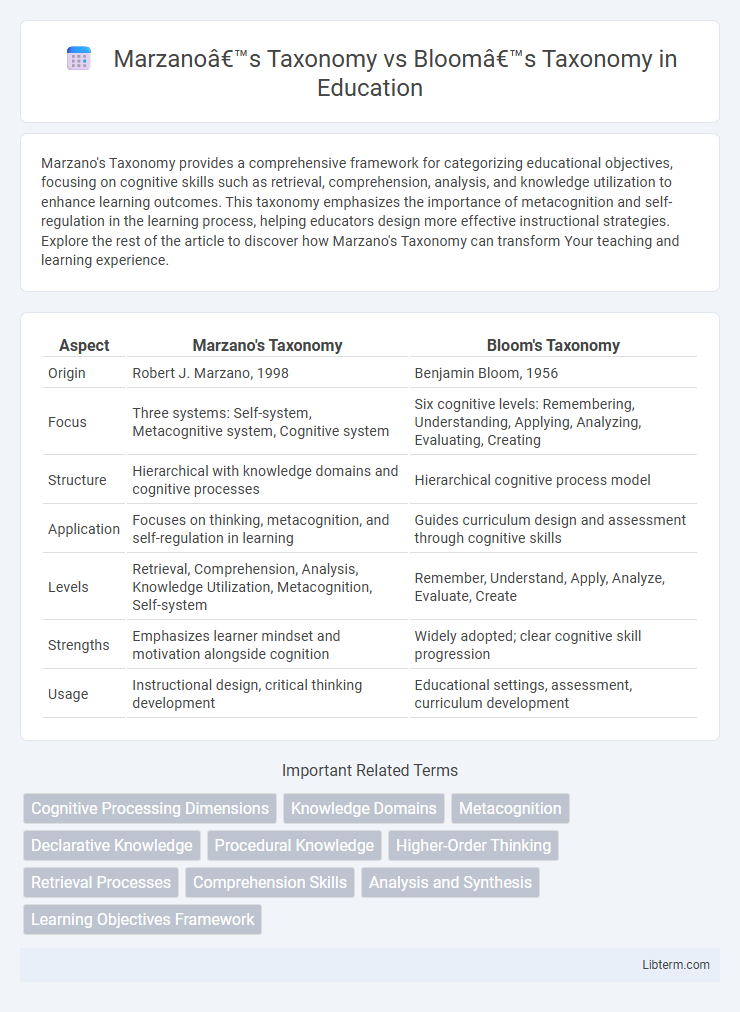Marzano's Taxonomy provides a comprehensive framework for categorizing educational objectives, focusing on cognitive skills such as retrieval, comprehension, analysis, and knowledge utilization to enhance learning outcomes. This taxonomy emphasizes the importance of metacognition and self-regulation in the learning process, helping educators design more effective instructional strategies. Explore the rest of the article to discover how Marzano's Taxonomy can transform Your teaching and learning experience.
Table of Comparison
| Aspect | Marzano's Taxonomy | Bloom's Taxonomy |
|---|---|---|
| Origin | Robert J. Marzano, 1998 | Benjamin Bloom, 1956 |
| Focus | Three systems: Self-system, Metacognitive system, Cognitive system | Six cognitive levels: Remembering, Understanding, Applying, Analyzing, Evaluating, Creating |
| Structure | Hierarchical with knowledge domains and cognitive processes | Hierarchical cognitive process model |
| Application | Focuses on thinking, metacognition, and self-regulation in learning | Guides curriculum design and assessment through cognitive skills |
| Levels | Retrieval, Comprehension, Analysis, Knowledge Utilization, Metacognition, Self-system | Remember, Understand, Apply, Analyze, Evaluate, Create |
| Strengths | Emphasizes learner mindset and motivation alongside cognition | Widely adopted; clear cognitive skill progression |
| Usage | Instructional design, critical thinking development | Educational settings, assessment, curriculum development |
Introduction to Educational Taxonomies
Marzano's Taxonomy and Bloom's Taxonomy both serve as foundational frameworks in educational taxonomies, guiding curriculum design and assessment strategies. Bloom's Taxonomy categorizes cognitive skills into six hierarchical levels: Remembering, Understanding, Applying, Analyzing, Evaluating, and Creating, emphasizing a progression from basic recall to higher-order thinking. Marzano's Taxonomy expands on this by incorporating self-system thinking, metacognition, and knowledge domains, offering a more comprehensive model that aligns with modern educational objectives and learner-centered approaches.
Overview of Bloom’s Taxonomy
Bloom's Taxonomy categorizes cognitive skills into six hierarchical levels: Remembering, Understanding, Applying, Analyzing, Evaluating, and Creating, providing a framework for educators to design curriculum and assessments. This taxonomy emphasizes the progression from basic knowledge recall to higher-order thinking skills, facilitating targeted learning objectives and effective instructional strategies. Widely adopted in educational settings, Bloom's Taxonomy serves as a foundational tool for promoting critical thinking and deeper comprehension.
Overview of Marzano’s Taxonomy
Marzano's Taxonomy organizes cognitive processes into three systems: the self-system, the metacognitive system, and the cognitive system, emphasizing the role of motivation and self-regulation in learning. It categorizes knowledge into four types--information, mental procedures, psychomotor procedures, and knowledge application--aiming for a more nuanced understanding of how students interact with content. This framework guides educators in creating lessons that develop higher-order thinking skills and promote deeper engagement compared to traditional taxonomies like Bloom's.
Key Similarities Between Marzano and Bloom
Marzano's Taxonomy and Bloom's Taxonomy both emphasize hierarchical cognitive processes to enhance learning and critical thinking skills. They share core components such as knowledge acquisition, comprehension, application, analysis, synthesis, and evaluation, aiming to promote deeper understanding and mastery. Both frameworks serve as essential tools for educators to design curriculum, assess learning outcomes, and foster higher-order thinking in students.
Fundamental Differences in Structure
Marzano's Taxonomy emphasizes a hierarchical model centered on self-system thinking, metacognitive system, and cognitive system, which integrates emotional and motivational dimensions into learning processes. Bloom's Taxonomy is structured around a linear progression of cognitive skills, ranging from Remembering and Understanding to Applying, Analyzing, Evaluating, and Creating. The fundamental difference lies in Marzano's inclusion of affective and metacognitive components, whereas Bloom's focuses primarily on cognitive skill classification.
Levels of Cognitive Processes Compared
Marzano's Taxonomy and Bloom's Taxonomy both categorize cognitive processes but differ in structure and emphasis; Marzano introduces self-system, metacognitive system, and cognitive system levels, emphasizing knowledge, skills, and attitudes, while Bloom's Taxonomy focuses on six hierarchical levels: Remembering, Understanding, Applying, Analyzing, Evaluating, and Creating. Marzano's model provides a more integrated approach by combining metacognition and self-regulation with cognitive tasks, contrasting Bloom's primarily cognitive skill progression. Bloom's framework remains widely used for its clarity in differentiating complexity of cognitive tasks, whereas Marzano's taxonomy supports deeper insight into student motivation and self-regulated learning.
Practical Classroom Applications
Marzano's Taxonomy emphasizes a hierarchical model focusing on cognitive systems such as retrieval, comprehension, analysis, and knowledge utilization, which aids teachers in designing lessons that progressively develop students' critical thinking skills through practical, step-by-step activities. Bloom's Taxonomy categorizes learning objectives into six levels from remembering to creating, providing a clear framework for educators to structure assessments and foster higher-order thinking by encouraging analysis, evaluation, and synthesis in classroom tasks. Both taxonomies guide instructional design and assessment strategies but Marzano offers more detailed behavioral components for active student engagement, while Bloom provides a broad conceptual hierarchy for curriculum planning.
Strengths and Limitations of Each Taxonomy
Marzano's Taxonomy offers a detailed framework emphasizing cognitive, metacognitive, and self-system processes, which supports personalized learning and self-regulation but may appear complex for quick implementation. Bloom's Taxonomy provides a straightforward hierarchical model focusing on cognitive skills from remembering to creating, fostering clear learning objectives but sometimes oversimplifies the learning process and lacks attention to affective and metacognitive domains. Educators often choose between Marzano's emphasis on deeper cognitive skills and self-awareness or Bloom's clarity and ease of use depending on instructional goals.
Choosing the Right Taxonomy for Instructional Goals
Marzano's Taxonomy emphasizes a structured approach to cognitive, metacognitive, and self-systems thinking skills, offering precise strategies for instructional design and assessment aligned with specific learning objectives. Bloom's Taxonomy provides a hierarchical framework categorizing cognitive skills from basic recall to complex evaluation, widely used for creating learning outcomes and assessment tasks. Selecting the right taxonomy depends on instructional goals: Marzano's taxonomy suits detailed skill development and learner self-regulation, while Bloom's taxonomy excels in framing broad cognitive objectives and assessment rubrics.
Future Trends in Cognitive Taxonomies
Marzano's Taxonomy emphasizes metacognitive strategies and self-system thinking, reflecting a shift toward personalized learning and deeper cognitive engagement. Bloom's Taxonomy, traditionally focused on hierarchical knowledge and cognitive skills, is evolving to incorporate digital literacy and critical thinking relevant to 21st-century education. Future trends in cognitive taxonomies highlight integration of technology-enhanced assessments and adaptive learning systems to better measure and support complex cognitive processes.
Marzano’s Taxonomy Infographic

 libterm.com
libterm.com